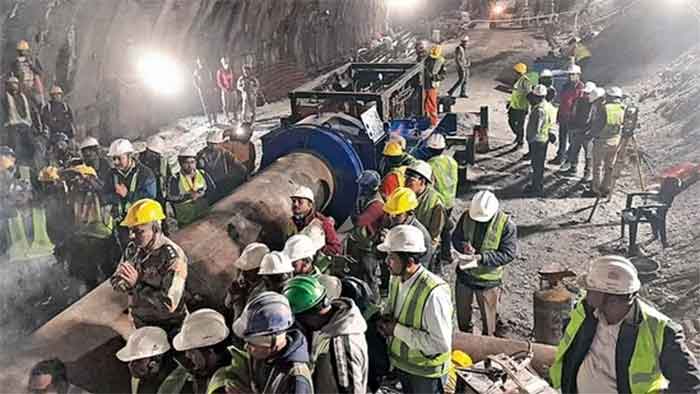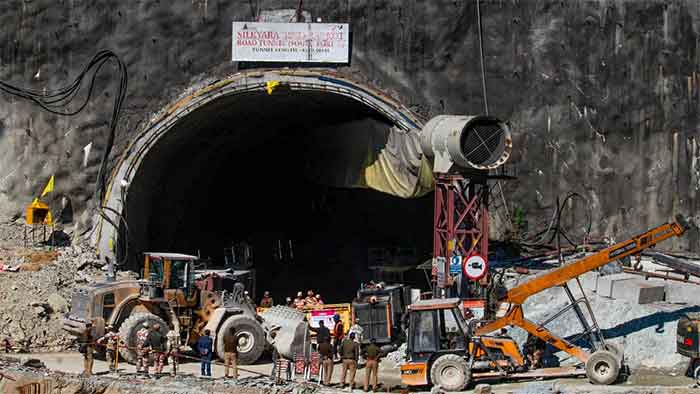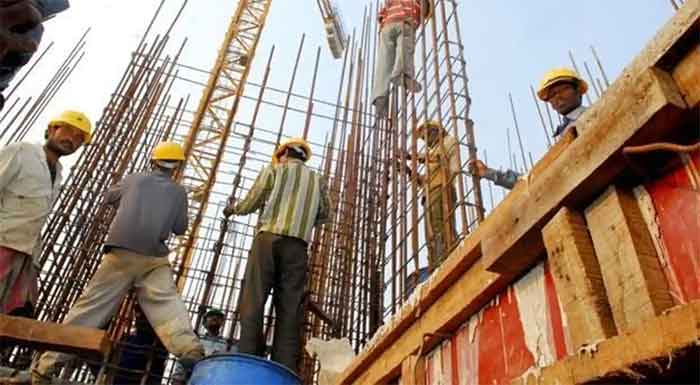
The accident at the Silkyara tunnel where 41 workers got trapped, has exposed not only vulnerability of such happenings but also poor state of emergency preparedness to deal with such accidents. It is generally the poor workers who are affected in such situations. Only in case of large scale hue and cry or when the stakes are very high on some other accounts, such accidents go either unreported or eventually leave the families of workers to keep on running from pillar to post for treatment if the person concerned survives or for compensation if the worker dies.
The Central Trade Unions have alleged that invariably it is the callous attitude of the government towards the occupational safety measures which leads to such accidents. Accidents at work places occur due to weaknesses of laws in regard to work place safety of workers and also laxity in their implementation and violations of whatever norms exist.
In this particular case of Silkyara, the team to monitor the rescue operation from the Centre was sent very late. The other workers who are outside are telling that the escape routes/tunnels, which are compulsory to meet such emergency situations in construction of long tunnels, were not even planned! The geologists and experts have come forward telling that the companies and agencies involved in tunnel construction in India tend to overlook safety concerns and measures suggested by them for the sake of cutting the costs and maximising profits! Principles of New Austrian Tunneling Method, which is both a construction method and a design philosophy, are also not followed in the true sense. There are serious concerns raised by one expert that the toxic gases being generated inside the tunnel are not being channelled out. The workers complained that the Hume pipes which were placed after one of the earlier accidents, had also been removed even before the completion of work at the tunnel.
Occupational Health and safety has been an issue of serious concern of health personnel as well as the workers’ organizations. The 60th World Health Assembly held in Geneva in 2007 charted out ‘Workers’ health: global plan of action’. It recognizes that the ‘workers represent half the world’s population and are the major contributors to economic and social development. But despite the availability of effective facilities there remain large gaps between and within countries with regard to the health status of workers and their exposure to occupational risks. Only a small number of them have access to occupational health services (1).
According to Ecology Global Network 55.3 million deaths occur every year (2). As per the International Labour organization (ILO) estimates 2.02 million ie 3.6% of total deaths each year occur from work-related accidents or diseases globally. A further 317 million people suffer from work-related diseases, and there are an estimated 337 million fatal and non-fatal work-related accidents per year. The suffering caused by such accidents and illnesses to workers and their families is incalculable. In economic terms, the ILO has estimated that 4% of the world’s annual GDP is lost as a consequence of occupational diseases and accidents (3). According to Indian Population Clock (4) in our country 9.7 million deaths occur every year. Out of this nearly 48000 are workers ie 4.8 % of total deaths (5) every year happen due to occupational accidents. The construction sector contributes 24.20 per cent of the fatalities (6). Many of these tragedies are preventable through the implementation of sound prevention, reporting and inspection practices (7).
India has a work force of about 54 crore people. Despite the fact that they are engaged in the productivity and development of the nation, they remain marginalized as far as healthcare services are concerned. Most of them are in unorganized sectors, who are devoid of any social security benefits. Nearly 3% of them are in government departments and public sector enterprises. Only they are covered under social security. Among the rest work force small number are in formal economy while vast majority, 93%, are in the informal economy. Other than Government and public sector employees, only about 11% of the total work force is covered under the social security schemes. Thus occupational safety is an issue of utmost importance.
The WHO had suggested that the ‘national policy frameworks for workers health should be formulated taking account the relevant international labour conventions and enact legislations to the effect. These should include establishment of mechanisms for inter-sectoral coordination of activities’. This is important because the impact on health in different sectors is different. Those engaged in mining are more prone to the diseases related to exposure to particular substance they are surrounded by. Those in nuclear industry face hazard of radiation exposure. The hospital workers are exposed to infections. The construction workers are more likely to meet traumatic injuries. The sewer men are exposed to waste material and poisonous gases. The methods of prevention, treatment and compensation also vary accordingly. Particular attention has to be paid to high-risk sectors of economic activity, and to the under-served and vulnerable working populations, such as younger and older workers, persons with disabilities and migrant workers, taking account the gender aspects(8).
Unfortunately the Labour Code on OSH & WC does not effectively address the concerns of the health safety of the working population. It has failed to address the primary issues of effective enforcement as also coverage of the larger sections of the Indian workforce.
The central trade unions point out that the Labour Code fails to address the universality of coverage. The code should cover all workers irrespective of nature of employment contract. Apprentice /trainee too must also be covered as they too are exposed to various risks as they are part of the work force. Because of little experience they are at a higher risk than regular employees.
The proposed labour code practically over-looks the concerns of workers employed in the non-registered establishments which accounts for over 93% of the total establishments / workers. The OSH concerns all the employees and workers. Exclusion of any group of workers or employees including supervisors and managers from its coverage is unethical.
Other categories of workers, such as agriculture workers, domestic workers, sewerage workers, salt workers, security guards, forest workers, Information Technology (IT) workers, Gig workers, Aanganwadi workers, etc. should also be included. There should be a specific chapter addressing the concerns of women workers.
If the workforce is not provided a clean, hygienic environment, potable drinking water and other such facilities, they cannot be expected to work to their optimum potential. The trade unions further point out that ‘an even more serious issue is when the establishments don’t show the full workforce on their records and many workers are just not there’ on the records maintained by the establishments. A visit to place of work and the accommodation in the industrial areas proves the point. The decision makers must realize that without a healthy workforce working in a conducive environment and guarantee of safety and health, productivity will be hit badly which will be detrimental to the interests of the country, the society and the employers. It must be accepted that occupational safety and health is a human right of all workers.
References:
1. https://www.who.int/occupational_health/WHO_health_assembly_en_web.pdf?ua=1
2. https://www.ecology.com/birth-death-rates/
3. https://www.who.int/occupational_health/WHO_health_assembly_en_web.pdf?ua=1
4. https://www.medindia.net/patients/calculators/pop_clock.asp
5. https://www.google.com/search?q=number+of+deaths+in+india+every+year&oq=number+of+deaths+in+india+every+year+&aqs=chrome..69i57j33.12477j0j8&sourceid=chrome&ie=UTF-8
6. https://timesofindia.indiatimes.com/business/india-business/48000-die-due-to-occupational-accidents-yearly-study/articleshow/61725283.cms
7. https://www.ilo.org/global/standards/subjects-covered-by-international-labour-standards/occupational-safety-and-health/lang–en/index.htm
8. https://www.who.int/occupational_health/WHO_health_assembly_en_web.pdf?ua=1
Dr Arun Mitra is a Practicing ENT Surgeon in Ludhiana, Punjab. He is also the President of Indian Doctors for Peace and Development (IDPD) www.idpd.org















































